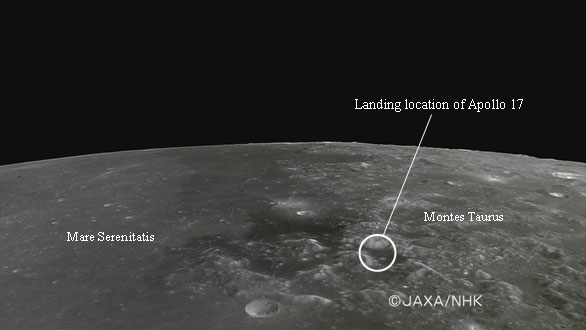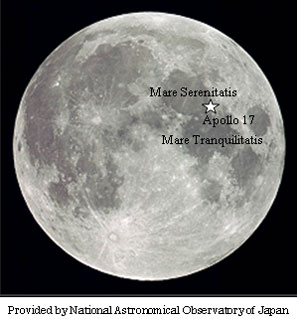KAGUYA (SELENE)
Transition to Operation Phase
Japan Aerospace Exploration Agency (JAXA)
The Japan Aerospace Exploration Agency (JAXA) is pleased to announce that the operation phase of the lunar explorer, KAGUYA (SELENE), was transitioned to normal operations from its initial check out on December 21 (Japan Standard Time, all the following dates and time are JST), 2007 as we were able to acquire satisfactory verification results for all fifteen observation missions. The results are shown in the following chart.
JAXA had been conducting an initial functional verification of the KAGUYA onboard systems (for both the bus and mission instruments) for about two months since the KAGUYA was injected into observation orbit at an altitude of about 100 km on Oct 18, 2007.
From now on, we will perform regular operations for about ten months to acquire data on "Moon Science" and other studies.
Although the X-ray Spectrometer and Charged Particle Spectrometer were found not performing its full specifications, we will cope with the problems during our normal operations while continuing to investigate the cause.
"Kaguya" Initial Check results
- Confirmed the system performance of the "Kaguya" main orbiter and sub-satellites ("Okina" and "Ouna") with expected results during the initial check.
- Verified electric, thermal and observation function performance of 15 observation missions. The results are shown in the following table. As there were no obstacles to start normal observation operations, the phase-up from initial check phase to normal operation phase was confirmed, though some remarks were identified.
| Observation Missions | Initial check out results for observation function | Remarks |
| X-ray Spectrometer (XRS) | It may be difficult to use the 4 CCDs mode to meet performance expectation standards for normal operations because there are some high-level noises. A study to reduce the noise is ongoing. One CCD mode will be applied for normal operations to meet expected performance levels to detect target element distribution although the spatial resolution of 1 CCD mode is two times bigger than that of 4 CCDs mode. | One CCD mode will be applied for normal operations for the moment. A study on the incident will continue to reduce the noise. |
| Gamma Ray Spectrometer (GRS) | The GRS worked fine and it detected Gamma rays from the lunar. The GRS is expected to discriminate incidents of gamma-ray energies with high precision and determine abundances of more than 10 elements in the lunar surface. | None |
| Multi-band Imager (MI) Spectral Profiler (SP) Terrain Camera (TC) |
The LISM (MI, SP and TC) worked fine and observed the Lunar surface data and spectral data. The LISM is expected to provide the first precise topographic, geologic, and mineralogical information on the moon. | None |
| Lunar Radar Sounder (LRS) | Planetary radio waves and plasma waves around the moon's orbit were observed without any interference from man-made noise from the earth and solar radiation. Sounding the surface and subsurface structures of the Moon by using HF radar technique with a frequency of 5 MHz was observed by the LRS. Through those results, the LRS observation function was confirmed. | None |
| Laser Altimeter (LALT) | The laser range data was obtained by LALT and the LALT is expected to construct a global, accurate and precise topographic map of the Moon. | None |
| Lunar Magnetometer (LMAG) | LMAG was confirmed specified capability of magnetic field measurements. | None |
| Charged Particle Spectrometer (CPS) | The CPS/ARD detected alpha rays emitted by the Rn on the lunar surface. The CPS/PS observed electron and proton around the moon. However, the CPS/PS could only observe heavy and light ion for several hours after it was turned on. This may be caused by thermal dependence of the regulators of single process sub-system. When the temperature of the regulator was low enough, heavy and light ion were detected by the CPS/PS. | Normal observations of the CPS will be performed with monitoring of the single process subsystem. A study on the incident will also continue. |
| Plasma energy Angle and Composition Experiment (PACE) | Data from the electron and solar wind ion from the Lunar surface was successfully observed by the PACE. | None |
| Radio science (RS) | A frequency change observation of the VRAD satellite (OUNA) was successfully performed for radio science. | None |
| Upper-atmosphere and Plasma Imager (UPI) | The observation function of the UPI extreme ultraviolet telescope (TEX) was verified to observe the plasmasphere and the observation function of the UPI visible telescope (TVIS) was also confirmed to observe global distribution of aurora and airglow. | None |
| Relay Satellite (RSAT) | Four-way Doppler measurements of the Main Orbiter (KAGUYA) by using the Relay Satellite (OKINA) for far-side gravity field were performed. | None |
| VLBI radio source (VRAD) | Orbits of the sub-satellites (OKINA and OUNA) were precisely determined by tracking the radio sources onboard the sub-satellites with a differential VLBI, which contributes to the accuracy of the gravity field, especially in the lunar limb areas. | None |
| High Definition Television (HDTV) | The HDTV shot movies of the earth rise, earth set and various lunar surfaces successfully. | None |
|
|
High definition image of the Moon taken after the critical phase
("Mare Serenitatis" near the location where Apollo 17 landed)


JAXA Video Archives: "KAGUYA" (SELENE)
| Date and time (JST) | Observation stat point | Observation end point | Notes |
| Bet. 10:47 and 55 p.m. on Nov. 14 | 75 deg S latitude and 71 to 92 deg E longitude | 51 deg S latitude and 80 to 88 deg E longitude | Lyot and Mare Australe |
| Bet. 3:21 and 29 a.m. on Nov. 19 | 13 deg N latitude and 27 to 32 deg E longitude | 37 deg N latitude and 26 to 33 deg E longitude | Posidonius and Mare Serenitatis |
| Bet. 3:14 and 22 a.m. on Nov. 22 | 65 deg S latitude and 176 to 163 deg E longitude | 87 deg S latitude and 248 to 90 deg E longitude | Crescent Earth Rise and Venus at the South Pole |
| Bet. 5:17 and 25 p.m. on Nov. 23 | 25 deg N latitude and 327 to 333 deg E longitude | 49 deg N latitude and 325 to 322 deg E longitude | Sinus Iridum and Montes Jura from Mare Imbrium |